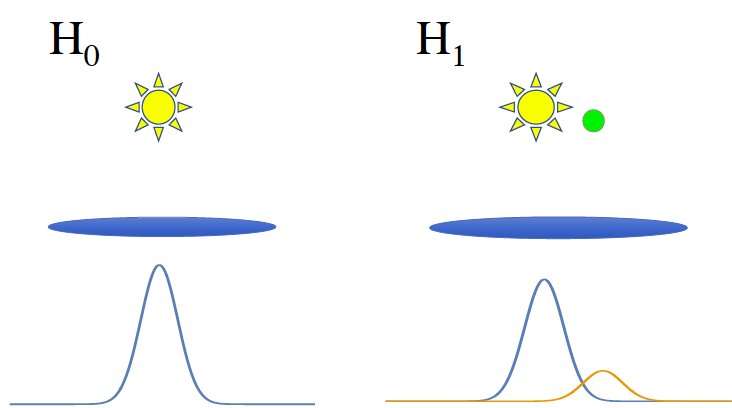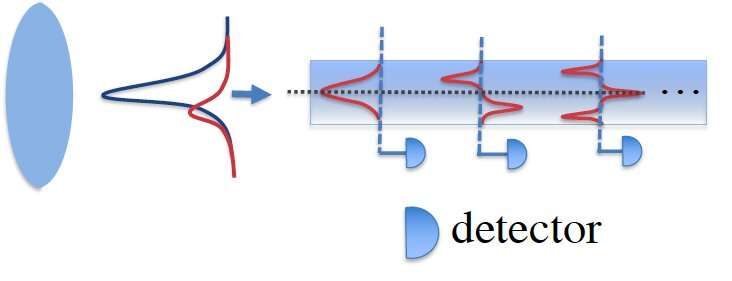October 7, 2021 feature
A new theory to test hypotheses and methods for exoplanet detection

Countless astrophysicists and astronomers are actively searching for unobserved celestial bodies in the universe, as detecting these bodies could improve our understanding of space and help to address unanswered astrophysical questions. Among these elusive objects are exoplanets, planets that orbit a star other than the sun, thus outside of the solar system.
One crucial challenge impeding the detection of exoplanets is that with existing methods, it is hard to see a faint emissions of a secondary source that is in the proximity of a much brighter source. This significantly limits the use of direct imaging techniques in exoplanet searches.
Researchers at University of Sheffield in the United Kingdom and Macquarie University in Australia have recently showed that it might be possible to reduce errors in detecting the presence of a weak secondary source during exoplanet searches, particularly in instances where two sources have small angular separations. Their paper, published in Physical Review Letters, specifically suggests that these errors could be reduced using quantum state discrimination and quantum imaging methods.
"Our work was inspired by recent papers on super-resolution quantum imaging, which was first rigorously quantified by Mankei Tsang and his colleagues at National University of Singapore," Zixin Huang, one of the researchers who carried out the study, told Phys.org. "These papers showed that the angular separation of two incoherent sources can be much better resolved by using quantum techniques (this is an estimation task, where the parameter we want to measure is the angular separation)."
The general idea behind the study conducted by Huang and her colleague Cosmo Lupo is that quantum techniques use the phase information that is contained in the optical signal. As this information is not properly exploited by direct imaging methods, quantum techniques could prove to be more effective.
While the researchers at University of Sheffield were first considering this idea, Huang watched a speculative documentary on Netflix called "Alien Worlds." The film speculates on possible life forms that could exist on other planets and explores what they may look like.

"While watching "Alien Worlds," it came to me to that quantum techniques could be used for a quantum discrimination task, as ultimately, the detection of exoplanets boils down to whether we tell the difference between one spot and two spots in the sky," Huang explained. "Bearing this in mind, we thought to study whether a quantum advantage can be obtained for a discrimination task. It turns out it can!"
Huang and Lupo applied an existing result in quantum information theory to bound the probability of a false negative (i.e., when an existing planet is missed by researchers). Such probability of error is expressed by a function called the relative entropy, which is either classical or quantum. Huang and Lupo showed that the quantum relative entropy is much larger than the classical one.
"In other words, the information is already there in the light; we simply calculated the ultimate quantum limit as to how well you can do with this task," Huang said. "We wanted to minimize false negatives, because planets are rare, and we would much rather make a mistake in finding something rather than missing it. With some luck, we also found the matching measurement that could achieve these error probabilities."
In the future, the method introduced by Huang and Lupo could serve as a benchmark for experimenters looking to assess the effectiveness of existing techniques for exoplanet detection. In addition, it could inspire the development of alternative optical imaging tools, both for astronomy and microscopy studies.
"Our method applies to a broad range of wavelengths, which means that the potential applications also include fluorescence microscopy, LIDAR detection, and other imaging techniques," Huang added. "We are now collaborating with Heriot-Watt University to perform a proof-of-principle experimental demonstration of the advantage discovered in the paper. We will also continue to investigate to what capacity quantum can help in imaging certain astronomical objects."
As part of their future work, Huang and Lupo also plan to design large baseline, entanglement-enabled telescope arrays for optical imaging. Most existing coherent telescope arrays are based on microwave technology. However, if the researchers were able to move these in the optical domain, they could potentially boost these technique's resolution by 3 to 5 orders of magnitude.
More information: Zixin Huang et al, Quantum Hypothesis Testing for Exoplanet Detection, Physical Review Letters (2021). DOI: 10.1103/physrevlett.127.130502
Mankei Tsang et al, Quantum Theory of Superresolution for Two Incoherent Optical Point Sources, Physical Review X (2016). DOI: 10.1103/PhysRevX.6.031033
Journal information: Physical Review Letters , Physical Review X
© 2021 Science X Network



















